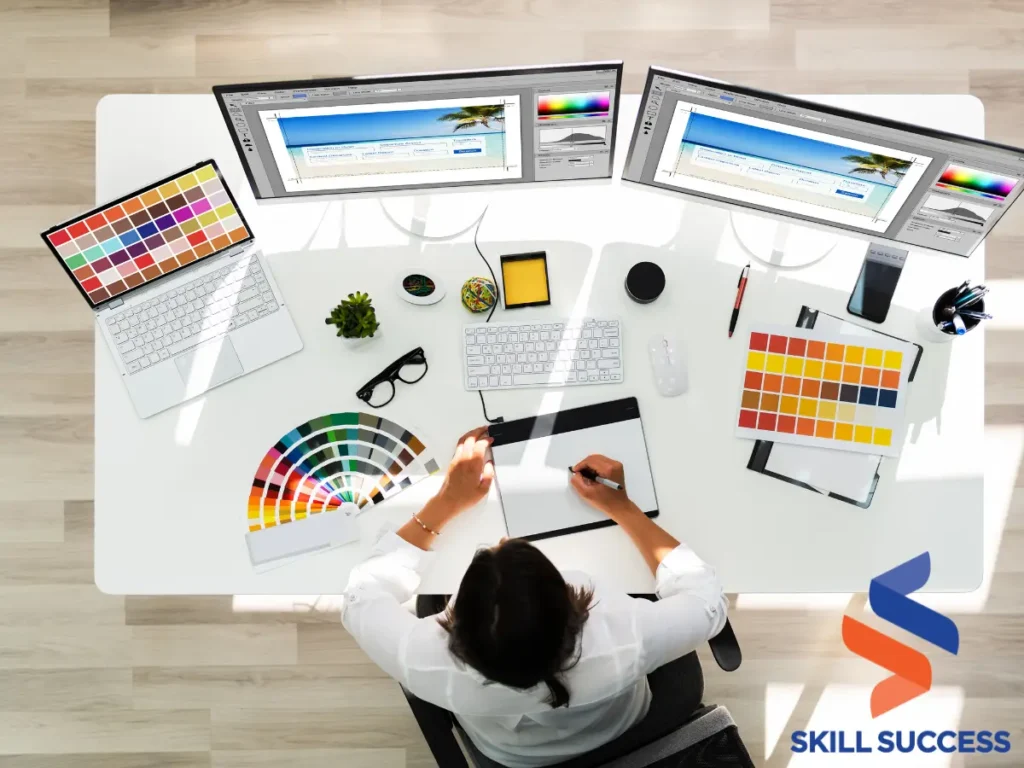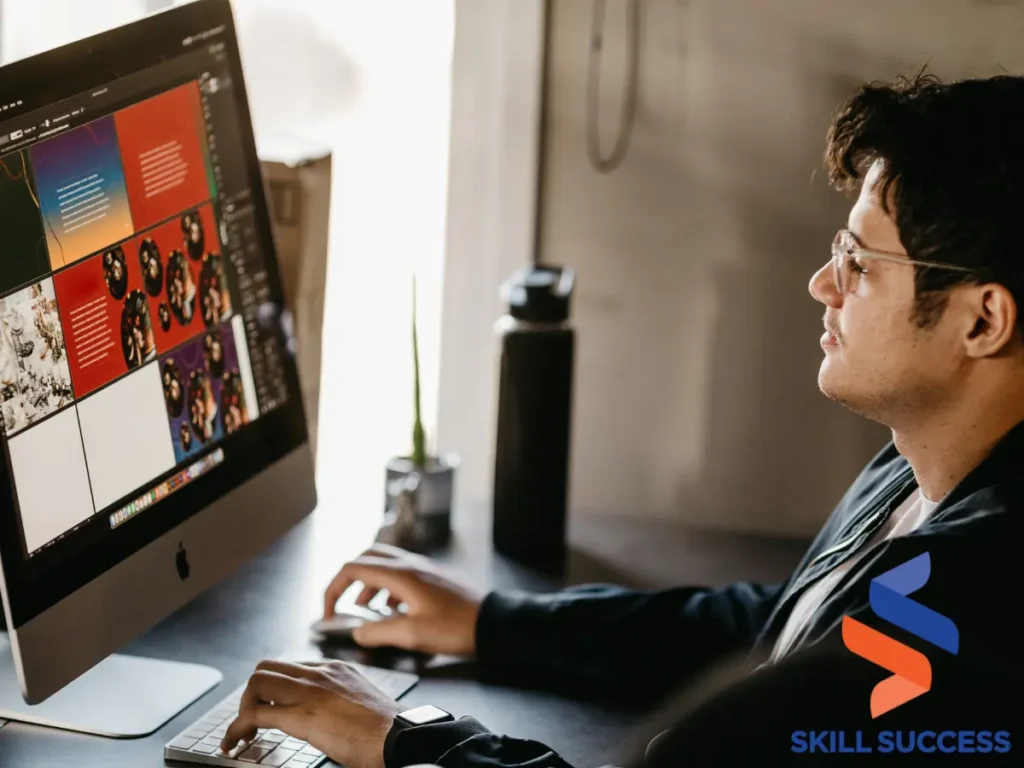Starting a freelance graphic design career can be exciting but also a bit overwhelming. This guide will help you understand the steps you need to take to start your journey in freelance graphic design. By following these steps and exploring top freelancing courses, you'll be well-equipped to find your niche, build a strong portfolio, establish an online presence, set competitive prices, and master client communication.

How to Start Your Freelance Graphic Design Career
Below are the practical steps to kick start your career in this promising industry.
1. Understanding the basics
What is freelance graphic design?
Freelance graphic design means you work for yourself and take on different projects for various clients. You’re your own boss, and you decide which projects to work on and when.
Why Freelance?
Freelancing offers flexibility and the opportunity to work on a variety of projects. You can set your own schedule and choose projects that interest you, whether it's website design, visual communication, or any other aspect of professional graphic design.
2. Finding your niche
What is a Niche?
A niche is a specialized area in which you focus. For example, you might specialize in logo design, website graphics, or social media visuals.
Why is a Niche Important?
Having a niche helps you stand out. Clients are more likely to hire you if you are known for being good at a specific type of design.
How to Choose a Niche?
Think about what type of design work you enjoy the most and what you are good at. Research what is in demand. Your niche should be a balance of your interests and market needs.
3. Building a portfolio
What is a portfolio?
A portfolio is a collection of your best work. It shows potential clients what you can do.
How to create a portfolio?
- Select your best work: Choose projects that show your skills and style. Provide them with jaw-dropping works by improving your graphic design skills.
- Show Variety: Include different types of designs to show your versatility.
- Keep It Updated: Regularly add new projects to your portfolio.
Where to host your portfolio?
There are many platforms where you can create a portfolio, such as Behance, Dribbble, or your own website. Having an online portfolio is crucial for a freelance graphic design business.
4. Establishing an online presence
Why is an online presence important?
An online presence helps clients find you and learn about your work. It also makes you look professional.
How to build an online presence?
- Create a website: Your website should include your portfolio, contact information, and a bit about you.
- Use social media: Platforms like Instagram and LinkedIn are great for sharing your work and connecting with potential clients.
- Join design communities: Participate in forums and groups to network with other designers and potential clients.
5. Setting your pricing
How to decide on pricing?
- Research industry standards: Look at what other freelance designers charge.
- Consider your experience: If you’re just starting, you might charge less, but as you gain experience, you can increase your rates.
- Project complexity: More complex projects should be priced higher.
Types of pricing models
- Hourly rate: Charge by the hour.
- Project-based: Charge a fixed price for the entire project.
- Retainer: A client pays a set amount each month for ongoing work.
6. Mastering client communication
Why is communication important?
Good communication ensures you understand what the client wants and that they are happy with the final product.
How to communicate effectively?
- Be clear and professional: Always be polite and clear in your communications.
- Ask questions: Make sure you understand the client's needs and expectations.
- Set expectations: Let clients know your process and timeline.
- Follow up: Keep clients updated on your progress and ask for feedback.
Here’s a comprehensive article on how to write cover letters as a freelance graphic designer.
Top Courses to Start a Freelance Graphic Design Career

How to Become a Freelance Artist: A Quick And Easy Guide
This course helps you turn your passion into profit. It offers practical skills for aspiring and experienced freelance artists, focusing on client communication, project management, and building a successful freelance career.
This course stands out due to Kristen Palana's real-world experience and practical teaching style. She transforms complex concepts into easy-to-follow steps, emphasizing both technical skills and personal traits essential for successful freelancing.
It is nothing short of practical and engaging. Kristen's insights from her freelancing journey provide valuable, relatable advice. It's ideal for both beginners and experienced freelancers looking to enhance their skills and confidence.
Who is this course for?
Perfect for those new to freelancing with no prior experience, as well as experienced freelancers seeking to improve client management and project completion. Creative professionals eager to monetize their talents will find this course especially beneficial.
TAKE THIS COURSEFrequently Asked Questions
How can I find my first clients as a freelance graphic designer?
Start by networking with friends and family, using social media, joining freelance job platforms, and participating in design communities and forums.
What software tools should I learn for graphic design freelancing?
Familiarize yourself with Adobe Creative Suite (Photoshop, Illustrator, InDesign), Sketch, Figma, and other popular design tools relevant to your niche.
How do I handle contracts and legal agreements with clients?
Use standard freelance contract templates available online, and customize them to include project scope, payment terms, deadlines, and intellectual property rights. Consulting with a legal professional can also be beneficial.
What are some effective strategies for managing multiple projects?
Use project management tools like Trello, Asana, or Monday.com to keep track of tasks, deadlines, and client communications. Prioritize tasks and allocate specific times for each project.
How can I improve my skills and stay updated with design trends?
Take online courses, attend workshops and webinars, follow design blogs and influencers, and regularly review the work of leading designers on platforms like Behance and Dribbble.

Key Takeaways
Starting a freelance graphic design career involves finding your niche, building a strong portfolio, establishing an online presence, setting competitive prices, and mastering client communication. With these steps, you can successfully launch and sustain your freelance graphic design career. Remember, every expert was once a beginner, so take it one step at a time and keep learning and improving.
For those looking to expand their skills even further, subscribe to the Skill Success All Access Pass. With this pass, you'll gain unlimited access to a vast library of courses, including advanced graphic design techniques, business skills, and more. Invest in your future and take your freelance career to the next level with Skill Success.

